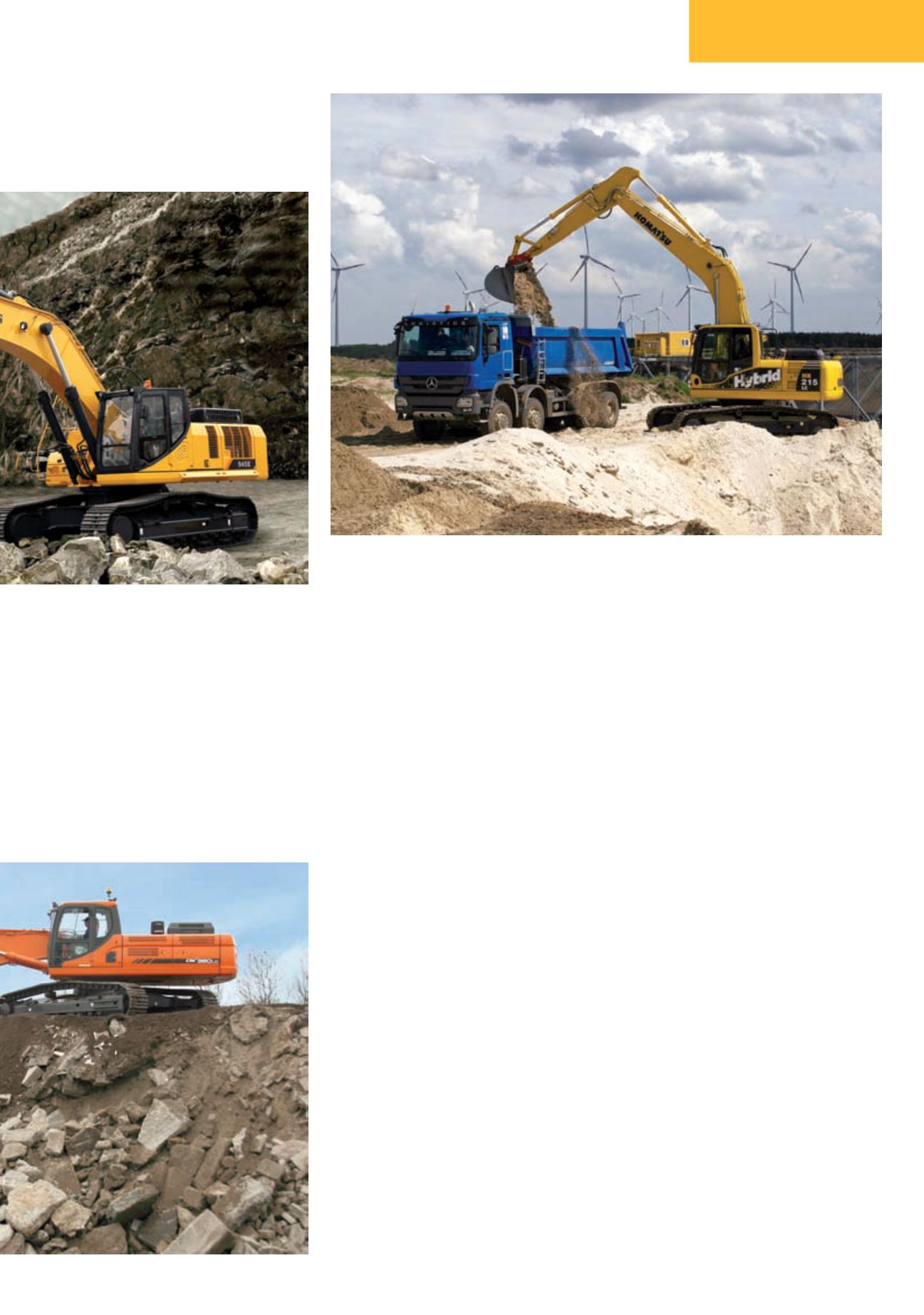
21
d
&
ri
JULY-AUGUST 2013
EXCAVATORS
manufacturers have the opportunity to use
their design skills and the best available
technology to build machines that are cheaper
to run than their competitors’.
A good example of this is JCB, which
uniquely in the industry achieved the Stage
IIIB emissions requirement on its own four
cylinder Ecomax engines without the use
of exhaust aftertreatment systems such as
a diesel particulate filter (DPF) or selective
catalytic reduction (SCR).
This has several advantages. First, fewer
on-board systems clearly keeps the purchase
cost down. Second, by the fine tuning that has
gone into the engine design has also improved
>
22
drive
Its first hybrid excavators were launched
in 2008, and since then the company says
it has sold more than 2,000 such 20-tonne
class excavators, logging more than 1 million
hours of work. The latest version, the 21.2
tonne HB215LC-1, was on display at Bauma
and the company says it offers 25% less fuel
consumption and CO
2
emissions than a
traditional excavator.
The machine achieves this by capturing
energy that would otherwise be wasted in
braking slewing movements of the upper
structure. Instead of a brake, a generator is
used to convert this energy to electricity,
which is stored in a capacitor. This is available
to rotate the upper structure back again or to
assist the engine in other ways, as dictated by
the on-board computer.
The use of capacitors - sometimes also
called super capacitors or ultra capacitors –
is an interesting one, given that hybrids in
the automotive industry have tended to use
more traditional batteries to store energy.
One advantage with capacitors is that they
can discharge their energy quicker than a
battery, which is more suitable to the stop-
start applications that are often found in
construction. They also have weight and size
advantages over batteries, and can accept and
deliver high currents.
Komatsu is the only manufacturer to have
an electrical hybrid excavator in production
today, although other manufacturers
including Doosan, Hitachi and Hyundai have
exhibited prototype 20 tonne class hybrid
excavators at various exhibitions over the last
few years.
But there has not been a great flood of such
machines onto the market. Part of the reason
for this may lie in the fact that global sales of
excavators remain sluggish in the wake of the
2008 financial crisis.
Another issue that excavator buyers have
fuel efficiency. Third, consumable costs are
lower as there is no DPF to service and clean,
and standard oils can be used, rather than
the more expensive low ash variants that are
required for use with aftertreatment systems.
Fourth, there is no need for extra consumables
such as the ‘Ad Blue’ urea solution that is
required for SCR.
JCB is now fitting its Ecomax engine across
its mid-range excavators from 11 to 22 tonnes.
The company said that it is seeing fuel savings
in the region of 10% compared to previous
generations. On a machine like the 22 tonne
JS 220 tracked excavator working a 1,600 hour
year, this could equate to savings of €5,200
(US$6,750) over a three–year period, based on
European diesel prices.
JCB has also recently launched a new
six cylinder Ecomax engine, the 672, which
initially is only compliant to Tier 2/Stage
II emissions, meaning that the machines it
will power, the JS330 and JS350, will only be
sold in developing regions of the world. A
Tier 4 Final/Stage IV version of this unit is
expected to be developed by mid 2015 for use
in machines destined for Europe and North
America. It is likely to have to be fitted with
an SCR to achieve this, but JCB is confident it
will not have to substantially change its engine
bay designs to accommodate it.
NEW TECHNOLOGY
So even with traditional diesel engines, there
are significant differences between what
competing manufacturers can offer in terms
of on-board technology and fuel efficiency for
excavators.
But now there is a growing move towards
augmenting traditional power sources with
new systems to save even more fuel. The most
talked-about is hybrid technology, and this
is an area where Komatsu has been a clear
leader.
Komatsu is the only company with a hybrid
excavator in full production. The latest model is
the 21.2 tonne HB215LC-1
Liugong launched its 45
tonne class 945E at Bauma.
Power comes from a 280 kW
Cummins QSM11 engine and
it suitable for markets where
Tier 2 exhaust emission laws
or lower are in force


